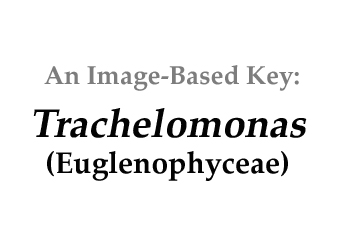|
Home / Euglenophyceae / Photosynthetic Euglenoids/ Trachelomonas |
||||
|
|
||||
 |
 |
|||
|
Click on images for larger format |
||||
Name derivation: |
||||
|
From the Greek trachelos, neck, and monas, unit |
||||
Classification: |
||||
Trachelomonas Ehrenberg 1835; 322 of 1738 species descriptions are currently accepted taxonomically (Guiry and Guiry 2013).Order Euglenales Family EuglenaceaeStrombomonas Deflandre (1930) was separated from Trachelomonas and subsequently subdivided into four sections on the basis of lorica development (Brosnan et al. 2005), but is considered a synonym in PhycoKey.
|
||||
Morphology: |
||||
|
Free swimming loricate unicell with single emergent flagellum. The lorica may be smooth or bear ornamentation, and is round or eliptical in most species. It always has a circular pore at the anterior end through which one flagellum protrudes. The lorica's shape and ornamentation are used to differentiate species. Often the lorica is hyaline impregnated with ferric hydroxide and manganic oxide that give it a dark reddish-brown color. During asexual reproduction, the nucleus divides yielding two daughter cells one of which exits through the opening in the lorica. The exited cell then synthesizes its own new lorica.
|
||||
Similar genera: |
||||
|
|
||||
Habitat: |
||||
References: |
||||
|
Brosnan, S., J.P. Brown, M.A. Farmer and R.E. Triemer 2005. Morphological separation of the euglenoid genera Trachelomonas and Strombomonas (Euglenophyta) based on lorica development and posterior strip reduction . Journal of Phycology 41: 590-605. Graham L. and Wilcox L. 2000. Algae. Prentice-Hall Guiry, M.D. and G.M. Guiry 2013. AlgaeBase. World-wide electronic publication, National University of Ireland, Galway. http://www.algaebase.org; searched on 30 July 2013. Credit to Wendy Guiry. Smith G. M. 1950. The fresh-water algae of the United States. McGraw-Hill, 2nd ed. |
||||













